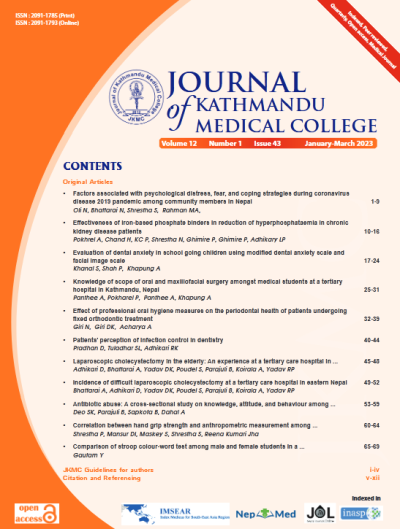Correlation between hand grip strength and anthropometric measurement among undergraduate medical students
DOI:
https://doi.org/10.3126/jkmc.v12i1.56694Keywords:
Body height, body mass index, body weight, hand grip strengthAbstract
Background: Hand grip strength is a simple procedure of assessing the function of hand and forearm. It can be used as a tool to evaluate nutritional status of individual, neurological disorder and to assess the post-operative status of the patient. The grip strength is affected by different variables such as geographical variation, gender, height, weight, body mass index and handedness of the individual.
Objective: This study aims to correlate hand grip strength with gender, height, weight, body mass index and handedness among Nepali population.
Methods: The study was analytical cross-sectional study conducted in students of Kathmandu University School of Medical Sciences. Convenience sampling was used. The height of the participants was taken by using Stadiometer in centimeter and weight was taken by using weighing machine in kilogram and body mass index was calculated. Hand grip strength was obtained by using Dynamometer measured in kilogram. The data were entered in Microsoft Excel Sheet and analysis was done in SPSS version 16.0.
Results: Hand grip strength showed moderate positive correlation with both height and weight both in both dominant and non-dominant hands. Hand grip strength was positively correlated in underweight, normal weight and obese category of body mass index whereas overweight category was negatively correlated.
Conclusion: Hand grip strength shows correlation with the gender, height, weight and body mass index.
Downloads
Downloads
Published
How to Cite
Issue
Section
License

This work is licensed under a Creative Commons Attribution-NonCommercial 4.0 International License.
Copyright © Journal of Kathmandu Medical College
The ideas and opinions expressed by authors or articles summarized, quoted, or published in full text in this journal represent only the opinions of the authors and do not necessarily reflect the official policy of Journal of Kathmandu Medical College or the institute with which the author(s) is/are affiliated, unless so specified.
Authors convey all copyright ownership, including any and all rights incidental thereto, exclusively to JKMC, in the event that such work is published by JKMC. JKMC shall own the work, including 1) copyright; 2) the right to grant permission to republish the article in whole or in part, with or without fee; 3) the right to produce preprints or reprints and translate into languages other than English for sale or free distribution; and 4) the right to republish the work in a collection of articles in any other mechanical or electronic format.




